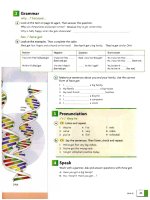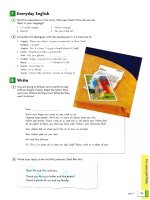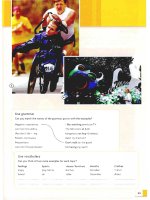Objective KET students book (bản mầu)
Bạn đang xem bản rút gọn của tài liệu. Xem và tải ngay bản đầy đủ của tài liệu tại đây (42.52 MB, 152 trang )
CA~1BRIOGE
UNIVERSITY
PRESS
Cambridge, New York, Melbourne, Madrid, Cape Town,
Singapore, Sao Paulo, Delhi, Mexico City
Cambridge University Press
The Edinburgh Building, Cambridge CB2 8RU, UK
www.cambridge.org
Information on this title: www.cambridge.org/978052 I I 78976
0 Cambridge University Press 2009
This publication is in copyright. Subject to statutory exception
and co the provisions of relevant collective licensing agreements,
no reproduction of any pan may take place without the wrinen
permission of Cambridge University Press.
First published 2009
6th printing 2013
Printed in Poland by Opolgraf
A catalogue record for this publiauion is available from th« British library
ISBN
ISBN
ISBN
ISBN
ISBN
ISBN
ISBN
ISBN
ISBN
978-0-521-17897-6
978-0-521-74461-4
978-0-521-74466-9
978-0-521-54149-7
978-0-521-54150-3
978-0-521-54151-0
978-0-521-54152-7
978-0-521.{)1994-3
978-0-521.{)1995-0
Practice Test Booklet without answers
Practice Test Booklet with answers with Audio CD
Pack
Student's Book
Teacher's Book
Cassette Set
Audio CD Set
Workbook
Workbook with Answers
Cambridge University Press has no responsibility for the persistence or
accuracy of URLs for external or third-party internet websites referred to in
this publication, and does not guarantee that any content on such websites is,
or will remain, accurate or appropriate. Information regarding prices, travel
timetables and other factual information given in this work is correct at
the time of first printing but Cambridge University Press does not guarantee
the accuracy of such information thereafter.
l·-· ·~· ·-
Shopping from home
BROWSE (RU Platrorms
'Browse EJectronlcArts Games
l•H1 ...-11t1)
• G;uneBoy
• PlnvStatton2
~
• Ganv:Cube
• PCGamcs
SCllrdl Ill l!lldtmilCNttGam":r-CI
Cricket 2004 (P52)
~
Amat.on.to.uk Review
UodltedOolly
w ~t~::}
a
~
Crick.ct.Love it.or hate rt. there's no denyingits ea!:
sunshine, rc~b<>O. tca bt-eaks. It's aD here in EA Sp
comprthcn.rr
;~ new SllllU!ation, Cricbt 1004 (pretty
l. Jomes Qpnd 007· Eyf:Nth!nOpr No!hloo CPS2l
929.99 You Sove:£10.00 (25%)~
~
2.BJ!WeftefdyiKnom
Our Price: £22.49 You Sove:£7.SO (25%)~
£1S.O'!___
Ip<...,. .........
MY'."1)1>
Typ;c'1ly. EA'•
ens ar e de ·
facrimilescfthcreal·lifpplaycnandcventsthcyportra
-
N
E
very song yo ,
..
u ve ever owned.
lh your pocket.
(~
(-- (
(
)
..
(~
1 What are these ways of shopping? Do you do any shopping
like this? Is it better than going into shops? Why? I Why not?
Listening
Kevin: Fine. Have you got any more things to
order?
Sally: Yes, I'd like some pool shoes for water
sports. They're on page (3)
.
How much are the blue and yellow
ones?
Kevin: Well, they were £16.50 but they're in
the sale now and they're only ( 4) £
.
But we don't have any left in small
sizes. What shoe size are you?
Sally: I'm a (5)
.
Kevin: Let me check. Yes, we've got a pair in
that size.
Sally: Great. Well, that's all I need. My name
and address is ...
2 Read the conversation. Don't worry about the
spaces at the moment. What is the
conversation about?
Kevin: Good morning. Swimshop, Kevin
speaking. How can I help you?
Sally: Hello. I've got your catalogue here and
I'd like some information. Can you
give me some prices?
Kevin: Of course. Please tell me the page
number you're looking at.
Sally: OK. The first thing is on page (1)
.
and it's the Maru swimming costume,
the blue and green one.
Kevin: OK, the small and medium sizes are
£22.65 and the large one is (2) £
.
Sally: Right. I'd like to order that, please, size
small.
3
n
Ji
j;!
------~~"~
tpp
.
Rcildtnor•
10
Top Sellers
r-
• PSone
• ~
I:
Now listen to the conversation and write
the missing numbers.
Grammar some and any
4 Look at these sentences from page 16.
1
2
3
4
5
I'd like some pool shoes.
I'd like some information.
Have you got any more things to order?
We don't have any left in small sizes.
Can you give me some prices?
Complete rules a-e with some or any and
match them to 1-5.
a We use some. with uncountable nouns in
affirmative sentences. II]
b We always use
in negative
sentences. D
c We use
with countable nouns in
affirmative sentences. D
d We use
for a request. D
e We usually use
in questions. D
G···::·
5 Complete the sentences with some or any.
1 I can't find
@!:f. sunglasses I like here.
2 There are
nice jackets in the
shops at the moment.
3 Are there
yellow surfing T-shirts
in the sale?
4 I want to buy
trainers, please.
5 Mum, can you lend me
money?
6 There's
great make-up in this
advert.
7 Has that website got
special
prices?
8 Why don't we buy
new DVDs?
9 There isn't
bread left - can you
get
in town?
10 Let's buy
new glasses.
page 136
Picture puzzle
Countable nouns usually have
different singular and plural forms, e.g. car, cars.
With uncountable nouns, there is only one form
of the word, e.g. toothpaste.
• To make a plural, we usually add -s:
one book
some books
• When the noun ends in -sh, -ch, -ss, -s or -x, we
add -es:
dish
sandwich
glass
bus
box
• Look at the pictures. Write the singular and
plural forms of the word under each picture.
lq
.
2
3&
4
~ ~
v
,=
~
~
:
....... ~
...... ~:?.
.
.
8
dishes
sandwiches
glasses
buses
boxes
~
• When the noun ends in -o after a consonant,
we also add -es:
tomato
potato
tomatoes
potatoes
• When the noun ends in -y after a vowel, we
add -s:
toy
toys
• When the noun ends in -y after a consonant,
we change y to i and add -es.
story
stories
• Some nouns have irregular plurals, for example:
woman
child
fish
foot
women
children
fish
feet
la
a
14
~
• Them write the last letter of each singular
form in the boxes below. They make three
words. Wloiat do the words say?
1 2 3 4
5 6
7 8 9 10 u 12 13 14
[rJDD1D DD DDDD1DD,DD
I Exam folder 2 I
Reading Part
Notices
1
Part 1 of the Reading and Writing paper is a matching task. There are five
questions and an example question. You must choose the correct answer from
eight notices (A-H).
1 These language areas are often tested in Part 1. Add another example to
each one.
I modal verbs .. .Y.t?.~
~
2 comparison .P.14~.f!!:.
3 imperatives . .P..t?.r/¢. :&.rg?.t.
· ·
·
4 prepositions
wit· h times
an d days of t h e wee k until 5 P!P..
5 prepositions with places .. r.i&X..¢. t.r?. l:h.~ r..f:.?..~.r.a.ri.~
.
.
.
.
.
2 Decide what sort of language is tested in the exam task above.
Underline examples of language areas 1-5 above in different colours.
Exam advice
Leek at tihe eight notices first to see what the topics are.
Read the ex-ample and its notice.
Cross out the e~ampie lettet, so that yon don't ehoese it again by accident.
Read each sentence carefully and underline the k~y words.
Look for notices that have similar language.
Dc;m't just match a word or number in the sentence and notice - this may
110t be the right answer.
• Check your answers when ycm tFansfer them te yeur answer sheet. Below
is an example of the answer sheet for Part 1.
•
•
•
•
•
•
Part 1
A B C D E F G H
1
CJCJCJCJDCJDCJ
2
c:JOCJDPDCJCJ
3
CJCJCJCJDCJCJCJ
4
DCJCJDCJCJ
5
A B C D E F
A B C
A.
D
E
B C D E
A B C
D
G H
F G H
r
8~
E F G H
CJCJDCJCJCJCJCJ
18
EXAM
FOLDER
2
Part 1
Questions 1-5
Which notice (A-H) says this (1-5)?
For questions 1-5, mark the correct letter A-Hon your answer sheet.
Example:
0 Do not leave any suitcases on the floor.
1 It is possible to swim later in
A
Buy train tickets at machine
when office is closed
the evening now.
2 This is cheaper because it
B
FOR SALE
Boy's bike, only 2 months old
Half usual price
isn't new.
3 All our prices are lower for a
short time.
c
4 You can pay for your journey
in a different way if necessary.
D
5 If you are 15 or younger, you
may win some money.
E
0
PLEASE PUT ALL LUGGAGE
ABOVE YOUR SEAT
0
I
SALE ENDS NEXT TUESDAY 15% OFF EVERYTHING UNTIL THEN
F
UNDER 16s GOLF COMPETITION
FIRST PRIZE £30!
G
SPEND £50 AND GET A
FREE SPORTS
H
BAG
POOL OPENING HOURS NOW l.:0NGER:
7 am - 10 pm (was 8.45 pm)
Breakfast, lunch and dinner
1 Look at the photos. Tell your partner what you see,
then complete the puzzle below to find the word in the
yellow squares.
G
A
E
H
F
0
T
IcI
3
E
B
R
0
E
s
1
2
3
4
5
always has a big breakfast? J"
buys a cake for a snack?
has chips or pizza for lunch?
thinks salad is good for you?
prefers water to juice?
6 doesn't like coffee or tea?
7 loves chocolate?
8 doesn't like ice cream?
D
HI
s
s
K
Pronunciation
2
n Listen and repeat these words. Then write them in group 1
or group 2 below.
meal
chips
fish
eat
leave
meat
fill
seat
dinner
feel
n
Listen to Jack and Katie
talking about food and drink.
Write J for Jack and K for
Katie. Who ...
biscuit
bin
tea
sit
live
beans
t'.Ul·*6idiiiili....,.Jl-i!i·,
n Listen to the recording to check your answers.
Vocabulary
4 What do you like? What don't you like? Talk about the food
8 Read the questions below.
Which answers are correct?
Put a tick next to them.
and drink in 1-7.
Excuse me, can you tell me the
time, please?
or
Have you got the time, please?
EXAMPLE:
I like apples best. I I preferapples.
I quite like oranges.
Grapes are OK.
I hate bananas.
1
2
3
4
5
6
7
grapes
nee
chicken
sandwiches
cake
JUlCe
carrots
apples
potatoes
steak
pizza
ice cream
lemonade
salad
A
B
C
D
Yes, of course. It's six o'clock.
No, I don't.
It's too early.
No, I'm sorry. I don't have a
watch.
E Nine minutes past three.
F Certainly, a quarter to four.
G I'm not sure.
oranges
bread
cheese
soup
chocolate
coffee
tomatoes
bananas
pasta
fish
burgers
biscuits
water
omons
5 Find out what four people in your class like and don't like.
Write down their answers.
g
What do you like?
Write: Sergio likes steak best and he doesn't like fish.
EXAMPLE: Ask:
Grammar Present simple
6 Complete this table with like.
affirmative
I/You/We/They
He/She/It
negative
I/You/We/They
He/She/It
question
Complete the table.
does + not = .M~f?.d.¢.
.
do+ not = ..M.n.'t.
.
has+ not=
.
have+ not=
.
is+ not=
chocolate.
bananas.
.
are+ not=
.
................................ fish.
..................................
oranges.
...... ................ I/you/we/they
...................... he/she/it
10
apples?
burgers?
LJ Listen to Rachel talking about
her day. Complete the notes .
Breakfast - 8.oo am
tea
(1)
toast
7 Match the times with the clocks.
b.
l\
ll 12 I
10
9o
'
~5
1
2
3
4
5
6
Lunch - (2)
11 12 I
2
C
LO
(\9
e.....,..
/
2
}
~~5
seven forty-five; a quarter to eight
one forty-two; eighteen minutes to two
four o' dock
two fifteen; a quarter past two
eight minutes past three
five thirty; half past five
.
pm
salad
a cake
(3)
Dinner - (4)
.
pm
chicken or (s)
rice or pasta
..
(6)
.
Tell your partner about
your day.
What can you see in the photo?
Reading
--------~
2 Read the text below about a festival in Spain.
--
ntonio lives in the city of Valencia in Spain. Every year
he goes to La Tomatina Festival in Buf\ol, a town near
Valencia. The festival is on the last Wednesday in
August, when everyone comes into the main square to throw
tomatoes at each other.
Before the fun begins, people cover the shop windows with
plastic. Antonio always wears his oldest clothes so he doesn't
get his best clothes dirty. He also always puts his camera in a
plastic bag to keep it clean. In the morning trucks arrive in the
main square, the Plaza del Pueblo, bringing more than
100,000 kilos of tomatoes. The fight begins at 11 o'clock and
always lasts for two hours. At exactly 1 o'clock everyone stops.
They never throw tomatoes after 1 o'clock. They then usually
spend the rest of the day cleaning themselves and the town!
In the evening, Antonio usually watches the fireworks, eats the
local food and sometimes joins in the dancing.
A
Are these sentences right or wrong? Underline the
part of the text with the answer in.
I Antonio comes from Bufiol.
2 The fe~tival is at the beginning of August.
3 Antonio never wears his best clothes to the
festival.
4 Everyone buys tomatoes from a local shop.
5 The fight usually lasts for more than two hours.
6 The next day everyone cleans the streets.
7 Antonio always watches the fireworks.
8 Antonio sometimes dances.
always
usually
She often
has a special meal on her birthday.
sometimes
never
Adverbs of frequency come ...
• before most verbs: He always goes to the festival.
• after the verb be: I am always late for dinner.
• Sometimes can also be placed at the beginning
or end of the sentence: I am sometimes late for
school. Sometimes I am late for school.
I am late for school sometimes.
3
Complete these sentences with always, often,
usually, sometimes or never.
1 I get up at 9 o'clock. (100%)
..t. ~W.~~ gfi.;;.. J~.P t#. 2....r/@fk.
2
3
4
5
6
7
My mother makes cakes on Tuesdays. (75%)
I am hungry at lunch time. (100%)
I am late for dinner. (55%)
Pete has a party on his birthday. (100%)
We have fireworks on New Year's Eve. (25%)
Sam meets his friends on New Year's Eve.
(90%)
8 You eat spaghetti
with a knife. (0%)
..
· 5 Tell your partner about your special days.
Reading
4 Read about
New Year in
Japan. Fill each
space with one of
the verbs from the box in the
correct form. Two of the verbs are negative.
stay begin
clean send
nng enJOY
We often have
fireworks.
eat (x 2) go (x 3) Eeme
watch listen drink
make receive do
Akiko Imai (1) fP.r.r!.f;:?. from Japan. Many young
Japanese people often (2)
away with their
usually
friends at New Year but Akiko (3)
......................... away, she (4)
at home with
her family. In Japan, New Year (5)
on 31st
TV
December. On that day,Akiko (6)
and (7)
a special kind of pasta called soba.
At midnight (12 o'clock), she (8)
to the
sound of the temple bell ringing. It (9)
.
108 times. On NewYear's Day, lstJanuary,Akiko
sake, a kind of rice
and her family (IO)
wine. After, they all (11)
popular foods
like rice cake and soup. It is a special day for
children because they (12)
some money
in special envelopes from their relatives. Before New
Year's Day.Japanese people usually (13)
.
their houses, (14)
a lot of food and
(15)
a lot of shopping. Akiko often
(16)
greetings cards to her friends.
New Year is one of the most important days in Japan
and Akiko always ( 17)
it because she
(18)
to school on that day!
What happens when there
is a festival in your town?
6 Write a note to a friend about a festival in
your town.
Say:
when the festival is
what you do at the festival
what you eat.
~
When's your birthday?
• Form groups of four to six students.
• Then everyone in the group must stand in
the order of the date of their birthday.
• The winners are the team who get in the
right order first. Everyone must be able to
say the date of their birthday in English.
If you can't, your team is out.
I
Writing folder 1
Writing Part 6
Spelling words
In Part 6 of the Reading and
Writing paper there are five
questions (36-40) and an
example. Each question is a
sentence which gives a
description of a word. You must
write the word, spelling it
correctly. The first letter of the
word is always given to you.
Here are some ways to practise
spelling.
1 Match the first part of the
word in A to the second part
in B. The words are all about
food and drink.
EXAMPLE: meat
1
2
3
4
5
6
7
8
9
10
A
me
but
wait
di
jui
mar
pas
tom
car
ap
B
ple
ce
ket
rot
ta
at
ato
ter
ress
sh
I
2 KET students often find some words difficult to spell.
Find the word which is spelled wrongly in each group and
correct the spelling.
1
2
3
4
5
6
7
8
9
10
11
12
favourite
~
actor
nurse
pink
white
bath
chair
husband
mother
beatiful
famous
television telefone
cloudy
sunney
wich
who
nice
friendly
hope
know
hospital
airport
disappointed
painter
yello
bed
daughter
rich
cooker
stormy
that
confortable
think
library
traditional d.4-ferent
pilat
grey
rmrrer
unkle
single
camera
windy
when
interesting
belive
appartment
3 Write a description for these words.
1
2
3
4
5
6
7
8
9
10
eat··············
U1 ······this
room .
a dining room ····I············
··························································
pizza
a waiter
a cafe
breakfast
a snack
a kitchen
a fridge
fruit
ice cream
4 Think of your own descriptions and ask your partner
what the answer is.
EXAMPLE: A: This is brown and it's very sweet. What is it?
B: Chocolate.
.








